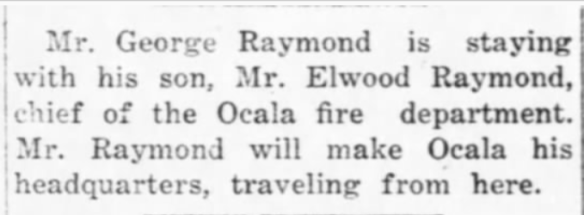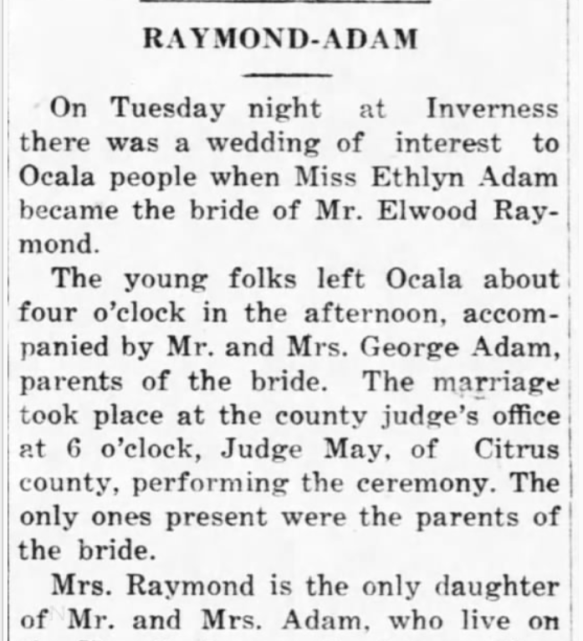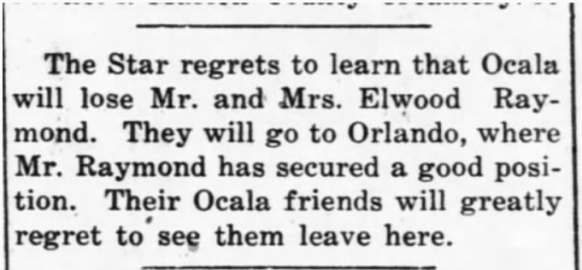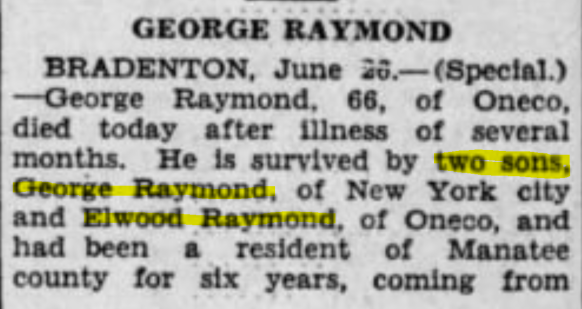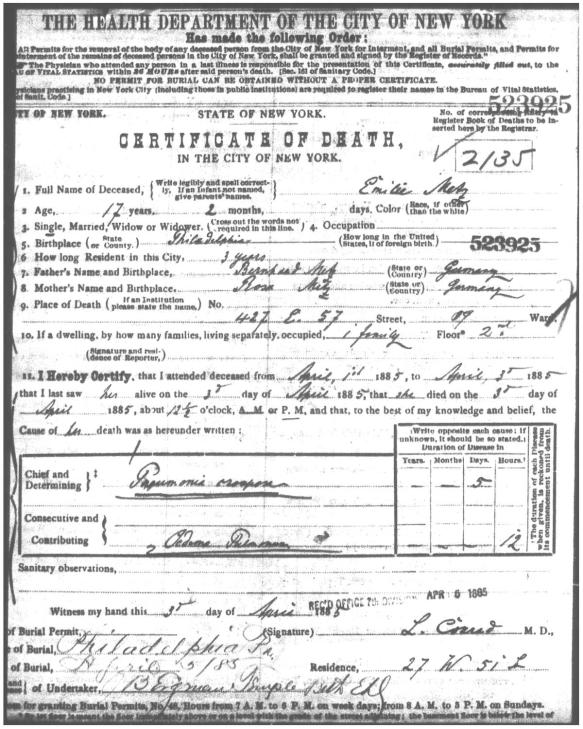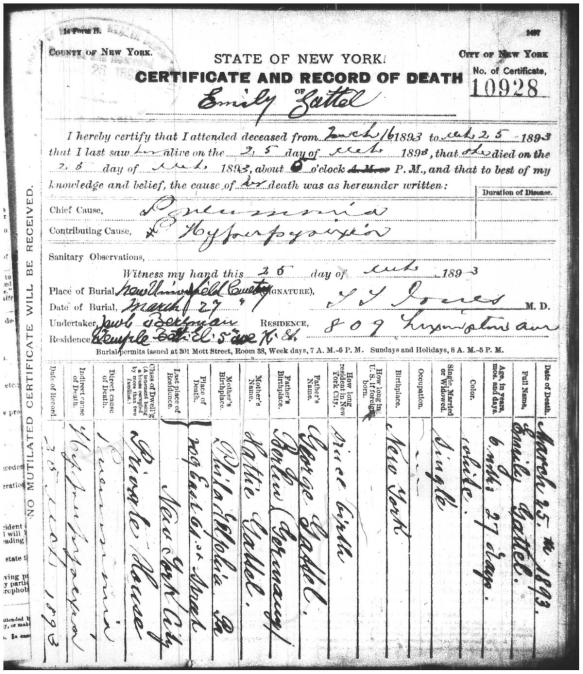This is the final post about the family of my three-times great-aunt Rosa Goldschmidt and her husband Bernhard Metz. In 1900, Rosa and Bernhard and three of their four surviving children were all living together in New York; Bernhard was still in the import-export business, and his sons Edwin and Joseph were merchants. Their daughter Hattie was working as a saleswoman, and her husband George Gattel was a commissioner. Rosa and Bernhard had already lost three of their children: Siegfried had died in 1880, Emily in 1885, and Bertha in 1892; also, their oldest son Paul had abandoned the family and disappeared in 1900.

Bernhard Metz family 1900 US census, Census Place: Manhattan, New York, New York; Page: 19; Enumeration District: 0661; FHL microfilm: 1241110
Ancestry.com. 1900 United States Federal Census
Rosa, Bernhard, Hattie and her husband George, Edwin, and Joseph were all still living together in 1905. Edwin was a “nit goods salesman;” Joseph was a dry goods clerk, George Gattel was some kind of salesman, and Bernhard was a commercial merchant. There were also two boarders and two servants living in the household at 209 East 61st Street.

Bernhard Metz family 1905 NYS census, New York State Archives; Albany, New York; State Population Census Schedules, 1905; Election District: A.D. 24 E.D. 16; City: Manhattan; County: New York; Page: 48. Ancestry.com. New York, State Census, 1905
Things changed between 1905 and 1910. We saw that Edwin, who had married Gertrude Becker in 1903, was living in Chicago in 1910. The youngest sibling, Joseph George Metz, also married during those years. He married Florence W. Wolf on December 31, 1905.

New York, New York City Marriage Records, 1829-1940,” database, FamilySearch (https://familysearch.org/ark:/61903/1:1:2497-DHX : 10 February 2018), Joseph Metz and Florence Wolf, 31 Dec 1905; citing Marriage, Manhattan, New York, New York, United States, New York City Municipal Archives, New York; FHL microfilm 1,558,583.
Florence was the daughter of Louis Wolf and Rebecca Stiefel, and she was born on September 20, 1884, in Fort Wayne, Indiana.1 Florence was living in New York City in 1900 with her parents and siblings; her father was a manufacturer.2 Florence and Joseph had their first child, Robert, on August 19, 1907, in New York.3
In 1910, Joseph Metz was enumerated as the head of household at 149 West 135th Street; in addition to his wife Florence and their son Robert (2), his parents Rosa and Bernhard were living there as well as two servants. Joseph was a ladies’ underwear manufacturer, and his father Bernhard was working as an insurance agent.

Joseph Metz and family 1910 US census, Census Place: Manhattan Ward 12, New York, New York; Roll: T624_1027; Page: 5B; Enumeration District: 0710; FHL microfilm: 1375040
Ancestry.com. 1910 United States Federal Census
Not too far away at 607 West 136th Street, Joseph’s sister Hattie was living with her husband George Gattel; George was now a silk merchant. Living with them was Hattie’s niece, the daughter of her deceased sister Bertha, eighteen-year-old Bertha Katzenstein. As you may recall, Rosa and Bernhard’s daughter Bertha Metz died shortly after the birth of her daughter Bertha from puerperal fever. I don’t know whether the child was named Bertha before her mother died or afterwards in her memory.

Hattie Metz Gattel and family 1910 US census, Census Place: Manhattan Ward 12, New York, New York; Roll: T624_1027; Page: 16A; Enumeration District: 0709; FHL microfilm: 1375040
Ancestry.com. 1910 United States Federal Census
Bertha Katzenstein’s father Adolf had remarried in 1895, three years after the death of his first wife Bertha Metz. His second wife, Lisbeth Schierstad, was a German immigrant like Adolf.4 I could not locate Adolf, Lisbeth or Bertha (the daughter) on the 1900 US census. Since Adolf was in the import-export business and traveled many times to Europe, I suppose that he and Lisbeth and Bertha might have been abroad when the 1900 census was taken. But Adolf and Lisbeth are listed on the 1905 New York State census, and Bertha was not with them at that time,5 nor was she with her grandparents or aunt or uncles. She would have been only thirteen at the time. Was she in boarding school? Still abroad? I don’t know. At any rate, in 1910, Bertha was back in New York City, living with her aunt Hattie.
Thus, in 1910, Rosa and Bernhard had only two of their seven children still living nearby: Hattie and Joseph. Paul had disappeared, Edwin was in Chicago, and Siegfried, Emily, and Bertha had passed away. They had five grandchildren: Bertha’s daughter Bertha Katzenstein, Edwin’s son Walter, Joseph’s son Robert, and the two sons of Paul Metz, Elwood and George.
On May 16, 1911, my three-times great-aunt Rosa Goldschmidt Metz passed away at age 73 from colon and liver cancer as well as kidney disease.

New York, New York City Municipal Deaths, 1795-1949,” database, FamilySearch (https://familysearch.org/ark:/61903/1:1:2WMM-ZTL : 20 March 2015), Rosa Metz, 16 May 1911; citing Death, Manhattan, New York, New York, United States, New York Municipal Archives
When I first opened this death certificate, I panicked. It showed Rosa’s parents as Jacob Goldsmith and Gretchen Stern, not Seligmann Goldschmidt and Hincka Alexander. Had I been researching the wrong Rosa Goldschmidt? But then I noticed her very specific age—73 years, 6 months, 19 days. Using a web date calculator, I determined that since she died on May 16, 1911, that meant she was born on October 27, 1837. Bingo! That is EXACTLY the date for Rosa’s birth on the Oberlistingen birth register, showing her parents as Seligmann and Hincka. Phew! But where in the world did the family come up with the names Jacob Goldsmith and Gertrude Stern?? I don’t know.
Two years after Rosa’s death her son Joseph named his second child for her; Rosalind Metz was born on May 21, 1913, in New York City.6
The following year Bernhard Metz died on August 10, 1914, in New York; he was 81.7
Meanwhile, Bertha Katzenstein was married on February 9, 1913, in Harburg, Germany, to Hermann Nathan. It was this fact that also led me to think that she had been living abroad for some part of her childhood. She was only twenty when she married, and six years later they were divorced on July 3, 1919, in Hannover, Germany. (Thank you to Matthias Steinke of the German Genealogy group for translating this document for me.)
Unfortunately that is the last document or record I have for Bertha Katzenstein. I don’t know whether she returned to the US, but if she did, I can’t find her in the US nor can I find her in Germany—not as Bertha Nathan or Bertha Katzenstein. If she remarried, I have no record of it and thus do not know her married name.
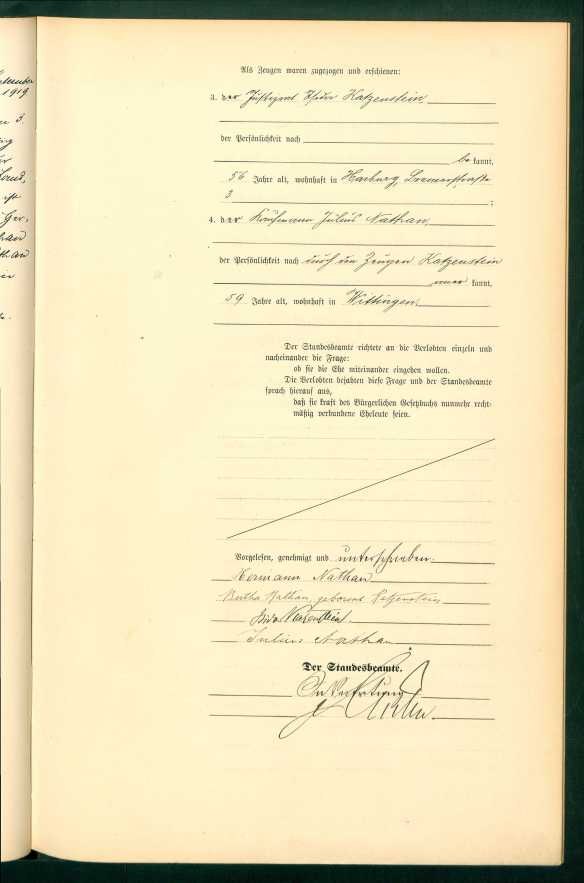
Ancestry.com. Hamburg, Germany, Marriages, 1874-1920.
Original data: Best. 332-5 Standesämter, Personenstandsregister, Sterberegister, 1876-1950, Staatsarchiv Hamburg, Hamburg, Deutschland. Certificate Number: 62
Reference Number: 332-5_11409
In 1920, Hattie and George Gattel were still living in New York City, and George was still selling silk. Ten years later they were still living in New York, and George was no longer working.8 Hattie died on December 11, 1930, at the age of 66;9 George died less than a year later on September 24, 1931.10 He was seventy. Having lost both of their children as babies, they have no direct descendants.
Joseph Getz, the remaining and youngest sibling, must have hit some hard times after 1910. In 1915, he and his wife Florence were living with Florence’s mother and brother Milton at 243 West 99th Street, and Joseph had no occupation listed on the 1915 New York State census.11 Their two young children, Robert, who would have been eight, and Rosalind, who was two, were not listed with them nor can I find them elsewhere on the New York State census. Could they have been omitted by mistake? Or were they living some place outside of New York, perhaps with a different relative?
I don’t know, but in 1920 Robert and Rosalind were again living with their parents in New York City; Joseph was now a commercial traveler. Florence’s mother Rebecca Wolf was also living with them.12 In 1925 they were all still living together, and Joseph was now an insurance broker.13 Five years later the 1930 US census shows them all living at the same place, Joseph still working as an insurance broker.

Joseph Metz and family, 1930 US census, Census Place: Manhattan, New York, New York; Page: 17B; Enumeration District: 0465; FHL microfilm: 2341292
Ancestry.com. 1930 United States Federal Census
Joseph and Florence’s two children married in the 1930s. Robert married Anna Steinhardt on June 29, 1934, and Rosalind married John L. Swartz on June 2, 1935.

Certificate Number: 17141, Ancestry.com. New York, New York, Extracted Marriage Index, 1866-1937. Historical Newspapers, Birth, Marriage, & Death Announcements, 1851-2003, Ancestry.com

Certificate Number: 11535, Ancestry.com. New York, New York, Extracted Marriage Index, 1866-1937. Historical Newspapers, Birth, Marriage, & Death Announcements, 1851-2003, Ancestry.com
Sadly, the decade ended with Joseph’s death on March 4, 1939. He was sixty years old.14 His wife Florence outlived him by more than 25 years, dying at 85 in September 1965.15 They were survived by their children and grandchildren.
With that, I come to the conclusion of the story of Rosa Goldschmidt, her husband Bernhard Metz, and their seven children. It was quite a wild ride at times. Rosa’s children faced many challenges and provided me with many research challenges. She was the youngest child of my three-times great-grandparents Seligmann Goldschmidt and Hincka Alexander. She was the second to last of their children to come to the US.
Her oldest sister and Seligmann and Hincka’s oldest child, Sarah, was the very last of the Goldschmidt siblings to come to the US. Her story comes next.
- Ancestry.com. U.S., Social Security Applications and Claims Index, 1936-2007, SSN: 058221651 ↩
- Louis Wolf and family, 1900 US census, Census Place: Manhattan, New York, New York; Page: 6; Enumeration District: 0832; FHL microfilm: 1241118. Ancestry.com. 1900 United States Federal Census ↩
- Ancestry.com. New York, New York, Extracted Birth Index, 1878-1909. Certificate Number: 3926. ↩
- Ancestry.com. New York, New York, Extracted Marriage Index, 1866-1937, Certificate Number: 13289. Lisbeth Schierstad Katzenstein passport application, National Archives and Records Administration (NARA); Washington D.C.; Roll #: 1744; Volume #: Roll 1744 – Certificates: 85500-85875, 23 Sep 1921-24 Sep 1921. Ancestry.com. U.S. Passport Applications, 1795-1925 ↩
- Adolf Katzenstein, 1905 NYS census, New York State Archives; Albany, New York; State Population Census Schedules, 1905; Election District: A.D. 31 E.D. 14; City: Manhattan; County: New York; Page: 42. Ancestry.com. New York, State Census, 1905 ↩
- Ancestry.com. New York, New York, Birth Index, 1910-1965, Certificate Number 27?? (not legible on index) ↩
- Ancestry.com. New York, New York, Extracted Death Index, 1862-1948 , Certificate Number: 23969. ↩
-
Hattie and George Gattel, 1920 US census, Census Place: Manhattan Assembly District 7, New York, New York; Roll: T625_1197; Page: 8A; Enumeration District: 555.
Ancestry.com. 1920 United States Federal Census. 1930 US census, Census Place: Manhattan, New York, New York; Page: 12A; Enumeration District: 0385; FHL microfilm: 2341288. Ancestry.com. 1930 United States Federal Census ↩ - Ancestry.com. New York, New York, Extracted Death Index, 1862-1948, Certificate Number: 28089 ↩
- Ancestry.com. New York, New York, Extracted Death Index, 1862-1948, Certificate Number 22939 ↩
- New York State Archives; Albany, New York; State Population Census Schedules, 1915; Election District: 16; Assembly District: 17; City: New York; County: New York; Page: 01. Ancestry.com. New York, State Census, 1915 ↩
- Joseph Metz and family, 1920 US census, Census Place: Manhattan Assembly District 23, New York, New York; Roll: T625_1226; Page: 18B; Enumeration District: 1489. Ancestry.com. 1920 United States Federal Census ↩
- Joseph Metz and family, 1925 NYS census, New York State Archives; Albany, New York; State Population Census Schedules, 1925; Election District: 34; Assembly District: 09; City: New York; County: New York; Page: 10. Ancestry.com. New York, State Census, 1925 ↩
- Ancestry.com. New York, New York, Extracted Death Index, 1862-1948, Certificate Number 5487. ↩
- New York Times, September 13, 1965, p. 35. ↩

























